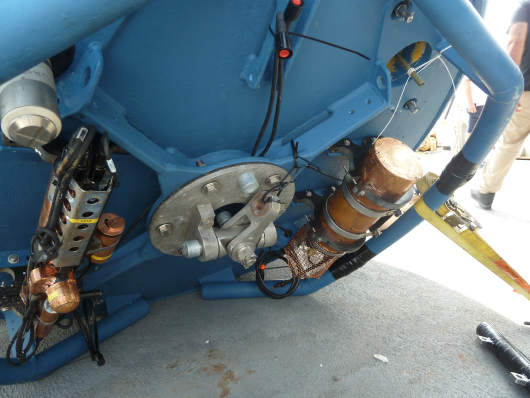NOAA Teacher at Sea
Samantha Adams
Aboard NOAA Ship Hi’ialakai
July 25 – August 3, 2017
Mission: Woods Hole Oceanographic Institution (WHOI) Hawaii Ocean Time-series Station deployment (WHOTS-14)
Geographic Area of Cruise: Hawaii, Pacific Ocean
Date: Monday 24 July 2017
Weather Data from the Bridge:
Latitude & Longitude: 21o22’N, 157o57’ W. Ship speed: 0 knots. Air temperature: 82oF. Humidity: 74%.Wind speed: 8 knots. Wind direction: East-South-East. Sky cover: Broken.
Science and Technology Log:
One of the first things you learn to do as a teacher is to plan for things to go wrong. When you put a lesson together, you try to identify potential problem areas, and then try to figure out how you could address those problems when they do arise, or try to avoid them altogether. One of the next things that you learn is that the biggest problem is invariably going to be something you never anticipated being a problem at all. Deploying a research buoy, it turns out, works essentially the same way.
Bird Wire
WHOTS stations are massive, self-contained buoys, designed to stay at sea for up to eighteen months, collecting data the entire time. There are redundant systems on top of redundant systems. Multiple meteorological instruments, measuring exactly the same thing, sprout from the buoy’s tower like misshapen mushrooms. If one instrument fails, there is always another — to ensure that, no matter what, the data is collected. And surrounding it all, like the spines of a porcupine, is the bird wire.
Anything that floats on the ocean winds can be a perch for birds, and the WHOTS buoys are no exception. I’ve been told that after a year at sea, the buoy is absolutely disgusting. I’ve seen some of the mess New York City pigeons can create, and I’m willing to bet that what I’m imagining cannot even come close. I’ll find out for myself later this week, when we retrieve the WHOTS buoy that was deployed last year!
Ick factor aside, birds (and their waste products) pose a real danger to the instruments on the buoy’s tower. If something is pecked or perched on or — use your imagination — otherwise damaged, the instruments may record corrupted data, or no data at all. Which is why there are redundant systems, and why Monday morning was spent making the buoy look like a porcupine. But wait! There’s more! It turns out all bird wire is not created equal. All of the spikes are made of stainless steel, but the spikes can be mounted on different things. Bird wire with a stainless steel base is more effective at repelling birds (because the spikes are closer together)… but the spikes have to be welded into the base, which magnetizes the bird wire. And if this wire is placed the instruments, it can affect their internal compasses and, in turn affect the data the bird wire is intended to protect! Bird wire with a plastic base is less effective (because the spikes are further apart), but much safer for the buoy’s instruments.
Cayenne Pepper, Copper and Things Covered in Tape
The tower of the WHOTS buoy isn’t the only thing that is absolutely disgusting after spending a year at sea. Everything that spends the year below the surface of the ocean (which will be described in a post later this week) comes back absolutely disgusting, too. And it’s not as though it can all just be thrown away. Of particular importance are the instruments attached under the buoy and about every 10 meters (down to 150 meters) along the buoy’s mooring line. All of these instruments must be returned to the manufacturer for calibration (to make sure they were working properly). But there’s a catch — they must be returned clean! Which means that everything that has been growing on them while they’ve been under water must be scrubbed, scraped or peeled off. To make the job easier, the search is always on for ways to keep things from growing on the instruments in the first place. This is called antifouling.
One antifouling method is painting. There are specialized antifouling paints available, but they can be toxic. So the paint that covers the exterior of the buoy contains cayenne pepper (!), which has proven to be as effective as specialized paint, but is much safer. Another antifouling method used on many of the instruments under the buoy involves replacing some stainless steel components with specially made copper ones, as copper also naturally impedes growth. And a third method that’s very popular is simply to cover the instruments with a layer of electrical tape, which can just be peeled off — no scrubbing or scraping involved!

MicroCats covered in black electrical tape. Notice the bracket on the top of each instrument — they are custom-made, out of copper, to make the cleaning process that much easier when the buoy is retrieved next summer.

Instruments on the bottom of the buoy. Once deployed, these instruments will be approximately three feet under water, which is why so much copper is used.
Personal Log:

“You’re lucky you weren’t here when we had to load for three months!”
Throughout the day, refrigerated trucks pulled up on the dock next to the Hi’ialakai. They were not full of delicate scientific instrumentation, but something just as vitally important to the cruise — food! The same crane that had been used to hoist instruments on board was also used to carry pallets of food from the dock to the deck of the ship. Then it was passed from hand to hand (by members of the ship’s crew, the science team, the ship’s officers, and the Teacher at Sea) all the way down to the galley’s refrigerators and freezers. The ice cream was handled with particular care — no surprise there!
Did You Know?
Woods Hole Oceanographic Institution’s acronym — WHOI — has a pronunciation! You can say it like “hooey”. Or “whoo-ey!” It means the same thing either way!
Share this:




